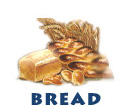

One aspect of the sacrificial cult often skimmed over in Hebrew school was
lehem ha-panim, sometimes translated as shewbread, or more palatably,
bread of display. Lehem ha-panim also has been translated as —
"the bread of the face (of God)" or ""the bread of the Presence". It is also
referred to in the Torah as lehem hamma'arekhet [1]
— "bread of the row" and as erekh lehem[2]
— "a row of bread."
 According
to the description in Leviticus, twelve cakes of pure wheaten flour were laid
out in two lines on a table which stood in front of the Holy of Holies, and were
renewed every Sabbath. These cakes (or loaves) were eaten at the end of the week
by the priests. While similar to the minhah in that it was a flour offering,
lehem ha-panim differed in that none of it was placed on the altar for
the "Most High." Frankincense (levonah; an ingredient of the incense),
however, was placed alongside each line of loaves as an azkarah (token/reminder
offering), and was burnt (on the altar of perfumes) when the priests removed the
loaves each Sabbath. According
to the description in Leviticus, twelve cakes of pure wheaten flour were laid
out in two lines on a table which stood in front of the Holy of Holies, and were
renewed every Sabbath. These cakes (or loaves) were eaten at the end of the week
by the priests. While similar to the minhah in that it was a flour offering,
lehem ha-panim differed in that none of it was placed on the altar for
the "Most High." Frankincense (levonah; an ingredient of the incense),
however, was placed alongside each line of loaves as an azkarah (token/reminder
offering), and was burnt (on the altar of perfumes) when the priests removed the
loaves each Sabbath.
Writes Bible scholar Roland de Vaux:[3]:
"The fact that incense was placed there justifies us in regarding the loaves as
something like a sacrificial offering, and Ezekiel himself likens the table on
which they were put to an altar.[4]."
This table is described as part of the furniture of the desert Tent of Meeting
— a table made of acacia wood, overlaid with pure gold,
with a rim of gold all around.[5]
Prof. Baruch Levine suggests that "two different modes of sacrifice are reflected
in the prescribed manner of offering the bread of display. The loaves themselves
were a presentation to God for which no altar of burnt offerings was used. The
bread was viewed by God and, by this means, accepted by Him. Subsequently, the
loaves were apportioned to the priests. In an effort to adapt this widespread
mode of sacrifice to the more distinctive method of burning offerings on the altar,
frankincense was to be burned near the loaves of bread; just as with other offerings
of grain, a small amount of flour was burned on the altar. God was pictured as
inhaling the aroma of the burning frankincense as 'an offering by fire.'"[6]
*
*
*
The practice of displaying
bread in the sanctuary is very ancient. There is a reference to this offering
in an account from the early career of David. While fleeing from Saul, David
and his men arrived at the sanctuary of Nob and were given some of the bread
of display to eat.[7]
According to ritual legislation, only priests were permitted to partake of these
consecrated loaves and, then, only within sacred precincts; the priest at Nob
checked that David's fighting men were in a pure state (that they "had kept
themselves at least from women") before he permitted them to eat of the bread.
According to medieval commentator Ibn Ezra, the twelve loaves represented the
Twelve Tribes of Israel, and the offering was symbolic of the pledge of the
Covenant between the Twelve Tribes and God. Just as a contract between men was
sealed and a form of friendship forged by their taking of a meal together[8],
so did ancient Israelite sacrifice seek to strengthen one's connection with
God. As in the case of all ancient sacrifice, the bread of display sought to
bring about God's appearance and his blessing. And God himself, by accepting
the gift (which of course He does not need) as part of the ritualized renewal
of the covenant, binds and obligates Himself in some way.
BREAD
Table of Contents
|